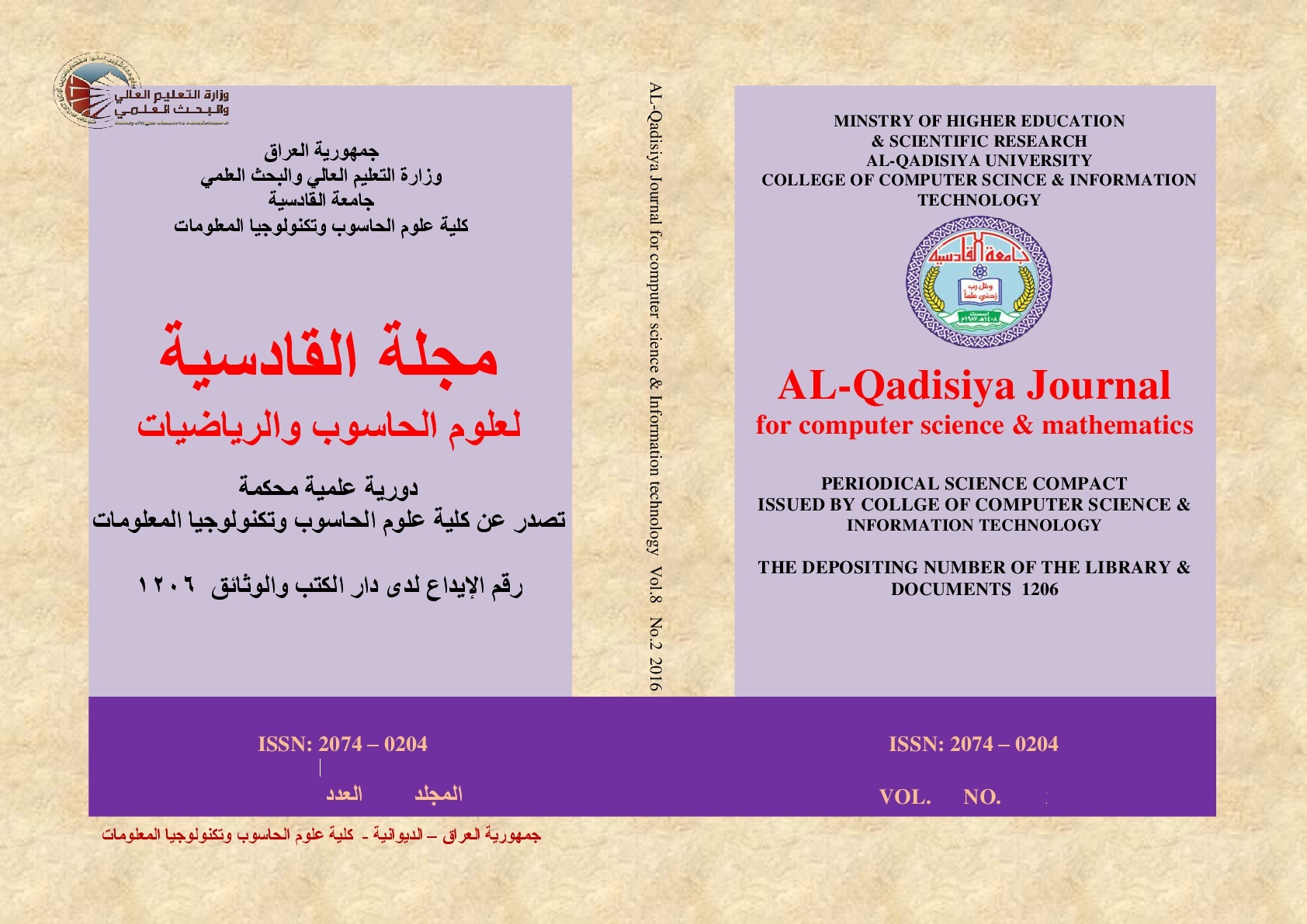Network Intrusion Detection Based On Deep Learning Method
DOI:
https://doi.org/10.29304/jqcsm.2025.17.22182Keywords:
Network Intrusion Detection Systems, Deep Belief Network, SVM, NSL-KDD, KDD CUP 99Abstract
With the increasing complexity of cybersecurity threats, Network Intrusion Detection Systems (NIDS) have become essential tools for securing organization networks. These Systems are designed to monitor traffic in real-time and detect unauthorized or malicious activities. Traditional machine learning algorithms have been extensively used for intrusion detection; however, most rely on shallow learning techniques, which are often ineffective in handling high-dimensional and complex network data. This study proposes a deep learning-based intrusion detection framework to address these limitations. The proposed method employs a Deep Belief Network (DBN) for deep feature extraction and dimensionality reduction, followed by a Multi-layer Perceptron (MLP) trained using the backpropagation algorithm to classify and detect intrusions. The approach is evaluated using two benchmark datasets: KDD CUP 1999 and NSL-KDD, selected for their diversity, labeled attack categories, and widespread used IDS performance benchmarking. Experimental results demonstrate that the proposed DBN-BP model achieves an average accuracy of 98.19% on KDD CUP 1999 and 98.17% on NSL-KDD. Experimental results demonstrate that the DBN-MLP approach achieves a recognition rate improvement of 13.45% over traditional SVM-based classifiers, additionally, on the KDD CUP 99 dataset, the DBN-MLP model demonstrates a 12.46% improvement over Decision Tree classifiers. These results confirm the model's superior learning capacity and enhanced ability to generalize to previously unseen attack types. This can be attributed to the hierarchical feature extraction capabilities of the Deep Belief Network combined with the classification strength of the Multi-layer Perceptron. Given these improvements, the DBN-MLP approach is highly suitable for real-time Network Intrusion Detection System (NIDS), especially in enterprise-level and cloud-based environments where high detection accuracy and responsiveness are critical.
Downloads
References
A. R. bhai Gupta and J. Agrawal, “A comprehensive survey on various machine learning methods used for intrusion detection system,” in 2020 IEEE 9th International Conference on Communication Systems and Network Technologies (CSNT), IEEE, 2020, pp. 282–289. Accessed: Mar. 28, 2025. [Online]. Available: https://ieeexplore.ieee.org/abstract/document/9115764/
M. M. Obaid and M. H. Saleh, “Efficient Intrusion Detection Through the Fusion of AI Algorithms and Feature Selection Methods,” J. Eng., vol. 30, no. 07, pp. 184–201, 2024.
A. S. Dina and D. Manivannan, “Intrusion detection based on Machine Learning techniques in computer networks,” Internet Things, vol. 16, p. 100462, Dec. 2021, doi: 10.1016/j.iot.2021.100462.
W. Li, W. Meng, and L. F. Kwok, “Surveying trust-based collaborative intrusion detection: state-of-the-art, challenges and future directions,” IEEE Commun. Surv. Tutor., vol. 24, no. 1, pp. 280–305, 2021.
G. E. Hinton, S. Osindero, and Y.-W. Teh, “A fast learning algorithm for deep belief nets,” Neural Comput., vol. 18, no. 7, pp. 1527–1554, 2006.
J. Mirkovic and P. Reiher, “D-WARD: a source-end defense against flooding denial-of-service attacks,” IEEE Trans. Dependable Secure Comput., vol. 2, no. 3, pp. 216–232, 2005.
E. Hodo, X. Bellekens, E. Iorkyase, A. Hamilton, C. Tachtatzis, and R. Atkinson, “Intrusion Detection System”, Accessed: Mar. 28, 2025. [Online]. Available: https://journals.riverpublishers.com/index.php/JCSANDM/article/download/5217/4577?inline=1
J. Yuan, D. Oswald, and W. Li, “Autonomous tracking of chemical plumes developed in both diffusive and turbulent airflow environments using Petri nets,” Expert Syst Appl, vol. 42, no. 1, pp. 527–538, Jan. 2015, doi: 10.1016/j.eswa.2014.08.005.
J. Zhang, M. Zulkernine, and A. Haque, “Random-Forests-Based Network Intrusion Detection Systems,” Syst. Man Cybern. Part C Appl. Rev. IEEE Trans. On, vol. 38, pp. 649–659, Oct. 2008, doi: 10.1109/TSMCC.2008.923876.
E. Hodo et al., “Machine Learning Approach for Detectionof nonTor Traffic,” J. Cyber Secur. Mobil., vol. 6, no. 2, pp. 171–194, 2017, doi: 10.13052/jcsm2245-1439.624.
“Packet and Flow Based Network Intrusion Dataset | SpringerLink.” Accessed: Mar. 29, 2025. [Online]. Available: https://link.springer.com/chapter/10.1007/978-3-642-32129-0_34
M. Al-Qatf, Y. Lasheng, M. Al-Habib, and K. Al-Sabahi, “Deep learning approach combining sparse autoencoder with SVM for network intrusion detection,” Ieee Access, vol. 6, pp. 52843–52856, 2018.
A. P. Lauf, R. A. Peters, and W. H. Robinson, “A distributed intrusion detection system for resource-constrained devices in ad-hoc networks,” Ad Hoc Netw., vol. 8, no. 3, pp. 253–266, May 2010, doi: 10.1016/j.adhoc.2009.08.002.
M. R. Ayyagari, N. Kesswani, M. Kumar, and K. Kumar, “Intrusion detection techniques in network environment: a systematic review,” Wirel. Netw., vol. 27, no. 2, pp. 1269–1285, Feb. 2021, doi: 10.1007/s11276-020-02529-3.
M. A. Shyaa, N. F. Ibrahim, Z. Zainol, R. Abdullah, M. Anbar, and L. Alzubaidi, “Evolving cybersecurity frontiers: A comprehensive survey on concept drift and feature dynamics aware machine and deep learning in intrusion detection systems,” Eng. Appl. Artif. Intell., vol. 137, p. 109143, Nov. 2024, doi: 10.1016/j.engappai.2024.109143.
M. M. Rahman, S. A. Shakil, and M. R. Mustakim, “A survey on intrusion detection system in IoT networks,” Cyber Secur. Appl., vol. 3, p. 100082, Dec. 2025, doi: 10.1016/j.csa.2024.100082.
C. Zhang et al., “A hybrid MLP-CNN classifier for very fine resolution remotely sensed image classification,” ISPRS J. Photogramm. Remote Sens., vol. 140, pp. 133–144, Jun. 2018, doi: 10.1016/j.isprsjprs.2017.07.014.
F. Tlili, S. Ayed, and L. Chaari Fourati, “Exhaustive distributed intrusion detection system for UAVs attacks detection and security enforcement (E-DIDS),” Comput. Secur., vol. 142, p. 103878, Jul. 2024, doi: 10.1016/j.cose.2024.103878.
N. S. Musa, N. M. Mirza, S. H. Rafique, A. M. Abdallah, and T. Murugan, “Machine Learning and Deep Learning Techniques for Distributed Denial of Service Anomaly Detection in Software Defined Networks—Current Research Solutions,” IEEE Access, vol. 12, pp. 17982–18011, 2024, doi: 10.1109/ACCESS.2024.3360868.
“Evaluation of Collaborative Intrusion Detection System Architectures in Mobile Edge Computing | SpringerLink.” Accessed: May 30, 2025. [Online]. Available: https://link.springer.com/chapter/10.1007/978-3-030-69893-5_15
M. Ring, S. Wunderlich, D. Grüdl, D. Landes, and A. Hotho, Flow-Based Benchmark Data Sets for Intrusion Detection. 2017.
V. Marinova-Boncheva, “A Short Survey of Intrusion Detection Systems”.
Y. Liu, S. Zhou, and Q. Chen, “Discriminative deep belief networks for visual data classification,” Pattern Recognit., vol. 44, no. 10, pp. 2287–2296, Oct. 2011, doi: 10.1016/j.patcog.2010.12.012.
F. Yang and D. Wang, “IoT-enabled intelligent fault detection and rectifier optimization in wind power generators,” Alex. Eng. J., vol. 116, pp. 129–140, 2025.
H. Zhang, D. Zhu, Y. Gan, and S. Xiong, “End-to-End Learning-Based Study on the Mamba-ECANet Model for Data Security Intrusion Detection,” J. Inf. Technol. Policy, pp. 1–17, 2024.
“Application of Multidimensional Data Analysis in Network Intrusion Detection System | International Journal of High Speed Electronics and Systems.” Accessed: Mar. 29, 2025. [Online]. Available: https://www.worldscientific.com/doi/abs/10.1142/S0129156425401901
Y. L. Khaleel, M. A. Habeeb, A. S. Albahri, T. Al-Quraishi, O. S. Albahri, and A. H. Alamoodi, “Network and cybersecurity applications of defense in adversarial attacks: A state-of-the-art using machine learning and deep learning methods,” J. Intell. Syst., vol. 33, no. 1, Jan. 2024, doi: 10.1515/jisys-2024-0153.
“A two-stage flow-based intrusion detection model for next-generation networks | PLOS One.” Accessed: Mar. 29, 2025. [Online]. Available: https://journals.plos.org/plosone/article?id=10.1371/journal.pone.0180945
“Testing Intrusion Detection Systems: A Critique of the 1998 and 1999 DARPA Intrusion Detection System Evaluations as Performed by Lincoln Laboratory,” ResearchGate, Oct. 2024, doi: 10.1145/382912.382923.
“(PDF) A Statistical Analysis on KDD Cup’99 Dataset for the Network Intrusion Detection System,” in ResearchGate, 2024. doi: 10.1007/978-981-15-3852-0_9.
“(PDF) Performance analysis of NSL-KDD dataset using ANN,” in ResearchGate, doi: 10.1109/SPACES.2015.7058223.
Downloads
Published
How to Cite
Issue
Section
License
Copyright (c) 2025 Dhafer Alhajim

This work is licensed under a Creative Commons Attribution-NonCommercial-NoDerivatives 4.0 International License.













